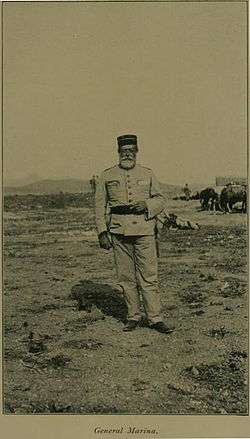Second Melillan campaign
| ||||||||||||||||||||||||||||
The Second Melillan campaign (the "Melilla War" or Guerra de Melilla in Spanish) was a conflict in 1909 and 1910 in Morocco around Melilla. The fighting involved local Riffians and the Spanish Army.
Prelude

After having lost the Spanish–American War in 1898, Spain sought compensation for its lost prestige by expanding its influence in Northern Africa. Spain had an agreement with Muley Mohamet, a local tribesman, to exploit mines around Melilla, against the wishes of Sultan Abd al-Aziz and other local tribes. On 8 August 1908, the Rifians attacked the mines, without causing any casualties, but Muley Mohamet was apprehended and sent to Fez, where he died in prison. Now without support in hostile territory, General José Marina y Vega, military commander of Melilla, asked Madrid for reinforcements to protect the mines, but none were sent. On 9 July 1909, a new attack occurred and six Spanish railway workers were killed by tribesmen.
Battles
As a result of these deaths, Prime Minister Antonio Maura Montaner increased the Spanish garrison at Melilla from 5,000 men to 22,000 in preparation for an offensive. All the Spanish forces involved were conscripts; at this stage, Spain had neither professional troops, nor indigenous troops under arms. The Spanish army was poorly trained and equipped and lacked basic maps.
The next day, the Spanish troops were shot at by francs-tireurs and skirmishes occurred near Melilla. General Marina decided to post six companies at Ait Aixa, under command of Colonel Álvarez Cabrera. They left Melilla at nightfall but got lost and, in the morning, found themselves in the Alfer Canyon, where they were decimated by gunfire from the heights. Colonel Cabrera and 26 men were killed, and 230 were wounded.
On 26 June, the Spanish suffered a second defeat at the Lobo Canyon, when Marina sent another force under General Pintos to protect Segunda Caseta. In this ambush, the Rifians killed General Pintos and 153 men, and wounded some 600 others.
Epilogue
After this disaster, the Spanish stopped all military operations. They raised troop-levels to 35,000 men and brought heavy artillery over from Spain. By the end of August the Spanish were ready and they launched a new attack. By January 1910 their overwhelming strength had enabled them to subdue most of the eastern tribes. The Spanish continued to expand their Melilla enclave to encompass the area from Cape Tres Forcas to the southern inlets of Mar Chica. However, this was achieved at the cost of 2,517 casualties.
